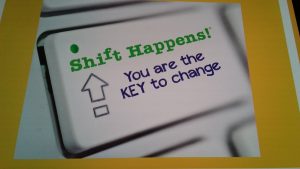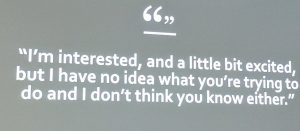MuseumNext in Melbourne 2017 was all about “risk”. If you don’t try, you don’t gain, but you also don’t lose. But many speakers took the time and care to stress that there are genuine costs to inaction. If you risk nothing, you can harm every aspect of your organisation. Nothing gained, nothing lost isn’t true. If you don’t try, you are automatically losing. If risks are not taken, your institution can become irrelevant, redundant and worse – purposeless.

I had serious session envy and was hungrily scanning Twitter in the breaks. Many times when deciding which session to go to I fervently wished I could split in two. I was transported to fantastical worlds with the Singapore Museum (Jervais Choo). I was excited by the Mahuki project at Te Papa and can’t wait to see the fruits from the accelerator program (Melissa Firth). I explored the wonders of technology with the Tate Museum’s IK Prize winners (Ros Lawler) and imagined the terrifying, a world with no internet (Aaron Straup Cope).

The presentations were inspiring, innovating and at times uncomfortable. I felt challenged and excited but I also noticed something missing. As the theme of this conference was “risk”, please bear with me as I step out of my comfort zone. After all, Elaine Gurian stressed that change often comes down to “individual bravery”, so let me be bold.
This conference was a call to arms. It was a battle cry to “pick a fight with whoever you need to, to do your job” (Aaron Straup Cope). It was a demand for museums to become political, to abandon the illusion of impartiality and to take a stand. To stand against oversimplification in our exhibitions and museums (Elaine Heumann Gurian, keynote). To stand up for open source and creative commons copyright (Jason Scott, keynote). To support the remix culture, unconventional ideas and new opportunities from technology. To fight for inclusion and our communities, even the ones we disagree with.
Indigenous Australian voices were not represented at this conference. This seemed surprising given that we were being told how important it is to take the risk of including more communities and groups of people. Auntie Joy Murphy Wandin, Wurundjeri elder representing the Kulin Nation, welcomed and opened the conference, providing each attendee with a gum tree leaf. And, most speakers gave an acknowledgement to country. Melissa Firth gave a beautiful korero and acknowledgement in Te Reo.
But for all the talk of audience engagement and inclusion at MuseumNext, aboriginal voices were omitted. Speakers used their platform to protest Trump, with cheers from the crowd. But “are we as vocal about other things going wrong in our communities?” (Elaine Gurian).
We need to change the happy feel good imagery of inclusion to reality. It’s not neat tidy boxes. There are raw emotions, stories, politics and untidy ends to inclusion. If we are to embrace complexity, these are the stories that need to be told.
We have to be better than this. We need to be better than this.
Every museum should have the ambition to change people’s lives; every museum is different, but all can find ways of maximising their social impact (Rowan Carroll).
Indigenous populations need to have a voice in the cultural institutions that house and protect their heritage. Otherwise, our institutions aren’t just irrelevant, they are exploitative. Aboriginal Australians not only deserve, but require a platform at these conferences. It is vital to have people driving decisions about their own heritage.
Apologies and acknowledgements are no longer enough. The minimum amount of effort we are willing to expend is no longer enough. The world is changing. If we don’t lead change, change will lead us.

